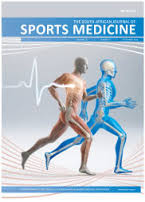Does a greater training load increase the risk of injury and illness in ultramarathon runners? : A prospective, descriptive, longitudinal design
DOI:
https://doi.org/10.17159/2078-516X/2020/v32i1a8559Abstract
Background: Ultramarathon running has become extremely popular over the years. Despite the numerous health benefits of running, there are also many negative effects of running, such as increased risk of musculoskeletal injury and illness. Monitoring of an athlete’s training load has become extremely important in terms of injury prevention. Currently, the relationship between training loads and injury and illness incidence is uncertain.
Objectives: To determine if there are any associations between injury and illness incidences and training loads among ultramarathon runners in the 12 week period preceding an ultramarathon event and the four week period after the event.
Methods: This prospective, descriptive, longitudinal study design was conducted in 119 runners who were training for the 2019 Two Oceans ultramarathon event. Data were collected once a week via an online logbook over 16 weeks. Training parameters measured included weekly average running distance, average duration, average frequency and average sessional RPE. Injury data included injury counts, the structure injured, the main anatomical location and the time-loss as a result of injury. Illness data included illness counts, the main illness-related symptoms and the time-loss as a result of illness.
Results: The overall injury incidence was five per 1000 training hours and the overall illness incidence was 16 per 1000 training days. There was a significant relationship between external training load and injury and illness incidence for those who ran less than 30 km per week. There was also a significant relationship between the ACWR (Acute Chronic Workload Ratio) and injury incidence when the ACWR was >1.5 and for illness incidence when the ACWR was <0.5.
Conclusion: The use of both absolute and relative workloads in the monitoring of an athlete’s training load with the aim of minimising injury and illness risk and maximising performance in ultramarathon runners is recommended.
Downloads
Downloads
Published
Issue
Section
License
The South African Journal of Sports Medicine reserves copyright of the material published. The work is licensed under a Creative Commons Attribution 4.0 (CC BY 4.0) International License. Material submitted for publication in the South African Journal of Sports Medicine is accepted provided it has not been published elsewhere. The South African Journal of Sports Medicine does not hold itself responsible for statements made by the authors.
How to Cite
- Abstract 1067
- PDF 629
Metrics

- Citations
- Citation Indexes: 2
- Usage
- Full Text Views: 117
- Abstract Views: 32
- Captures
- Readers: 21





.png)